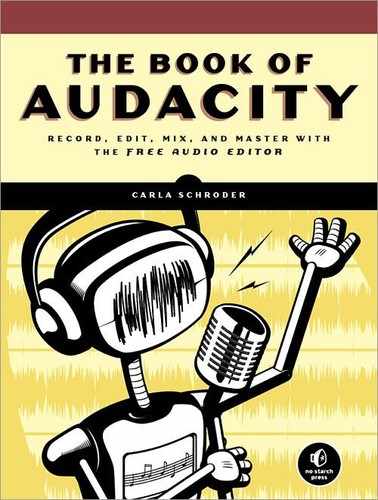Let’s run through the appropriate recording settings in Edit > Preferences. (Please visit Chapter 13 and Chapter 14 to learn how to, tune your PC for audio recording and managing your sound devices.)
First, open a new Audacity project and use File > Save As to save and name your new project. You can’t save changes while Audacity is recording, so you might take advantage of short breaks to stop recording, press ctrl-S or use File > Save Project, and then pick up where you left off with shift-Record.
Set your recording and playback devices on the Edit > Preferences > Devices tab and set the number of channels you are recording. Audacity will show only the number of channels that your recording interface supports. Windows users, always select Windows DirectSound and never MME for the Host, because MME is the antiquated generic Windows sound interface. You could select Primary Sound Driver for your recording and playback devices if you have only one sound card. If you have more than one, then select the specific recording interface from the drop-down Recording Device menu (Figure 4-4). (Your selections will be different, unless you have the same audio interfaces that I have.)
Figure 4-4. Setting the correct recording and playback devices in the Edit > Preferences > Devices dialog on Windows
Figure 4-5 shows how it looks on a Linux PC:
Figure 4-5. Setting the correct recording and playback devices in the Edit > Preferences > Devices dialog on Linux
You’ll probably want to review your recordings during breaks in the show, so set your playback device to something that outputs to headphones.
On the Recording tab, uncheck “Overdub,” “Software Playthrough,” and “Sound Activated Recording.” Leave your Latency settings alone unless you experience dropouts. Dropouts mean your CPU can’t keep up, so increase the Audio to buffer value until the dropouts stop (Figure 4-6).
The settings on the Quality tab (Figure 4-7) depend on what your analog-to-digital converter supports. Let’s say you have an analog mixer connected to a high-end sound card that supports up to 24/96 (24-bit depth, 96 kHz sampling rate); if you have enough hard drive space, you could record at 32-bit depth and 96,000 Hz sampling rate for ultimate high quality. (Bit depth is called Sample Format in this menu. Bit depth is the correct term.)
Figure 4-7. Settings in the Quality tab are determined by what your recording interface supports and your preference.
My MobilePre maxes out at 16/48, so I set Audacity to 32-bit float/48 for recording. It’s no good setting a higher sampling rate (upsampling) than your recording interface supports because there is no magic quality infusion. It wastes disk space and bogs down your CPU, and upsampling hurts audio quality. But there are benefits to recording at 32-bit float even on 16-bit sound cards, which is explained in Chapter 1. (See 16/44.1, 24/96, 32-Bit Float in 16/44.1, 24/96, 32-Bit Float to learn more about quality settings.)
If you are recording from a digital mixer or a mixer with its own digital output, then that will determine your maximum bit depth/sampling rate. For example, the Behringer Xenyx X2442USB 24-Channel Mixer is an analog mixer with a built-in ADC that delivers a 16/48 digital signal via USB. It plugs right into your computer, so you don’t need a sound card. So you could set Audacity to record at 32-bit float/48 for maximum quality. If 16/48 isn’t good enough, you could connect an outboard ADC that supports higher bit depths and sampling rates to the Xenyx’s RCA analog recording outputs.
Set your recording levels before you start by clicking the Input Level Meter (Figure 4-8). Because digital recording has such a high signal-to-noise ratio, which is also called a low noise floor, you can set a conservative peak level to allow for the unpredictability of a live performance. It’s not like recording on tape where we had to push recording levels as high as possible to keep noise levels at acceptable levels; you don’t want to go over zero in digital audio because that causes distortion. I aim for a peak level of -24 dB for live shows. The Meter toolbar has a little handle on the right to make it longer or shorter, and the handle on the left is for dragging it anywhere you want, even outside of Audacity.
When you’re ready to start recording, just click the red Record button. Click Pause to stop and then Record to continue on the same track. Clicking Stop and then Record starts new tracks, so if you stop when you meant to pause, pick up again on the same track by pressing shift-Record.
The best way to monitor your recording is by plugging headphones into a monitoring port. For example, the MobilePre has a zero-latency monitoring port, and there are always monitoring ports on mixers. The better recording interfaces have zero-latency monitoring ports, which is a good thing to look for when you’re shopping.





